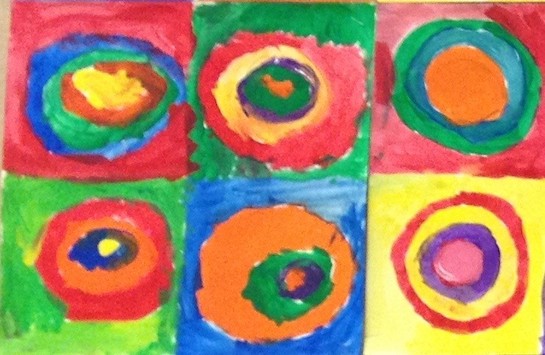Students create concentric circles with contrasting colors, learning how to express moods and feelings through their artwork. Recommended for 1st Graders.
Color: an element of visual art; the visible range of reflected light. Color has three properties: hue, value, and intensity.
- Complementary Colors: contrasting colors; colors that are opposite on the color wheel, such as yellow/violet, blue/orange, and red/green.
- Cool Colors: a group of colors on the color wheel that includes blues, greens, and violets; in an artwork, cool colors appear to be farther away from the viewer. Cool colors bring to mind cool things, places, and feelings.
- Warm Colors: a group of colors on the color wheel that are associated with warmth, such as red, yellow, and orange. In an artwork, warm colors appear to advance toward the viewer. Warm colors can evoke feelings of warmth like sun, fire, heat.
Shape: an element of visual arts; a two-dimensional (flat) area enclosed by a line: Geometric: shapes and/or forms that are based on mathematical principles, such as a square/cube, circle/sphere, triangle/cone, or pyramid. Organic: shapes and/or forms that are irregular, often curving or rounded, and more informal than geometric shapes.
Value: an element of visual arts; the lightness and darkness of a line, shape, or form; a measure of relative lightness and darkness.
Contrast: a principle of design; a technique that shows differences in the elements of visual arts in an artwork, such as smooth/rough textures, light/dark colors, or thick/thin lines.
Pattern: a principle of design; the repetition of the elements of visual arts in an organized way; pattern and rhythm are both created through repetition; see rhythm for examples of regular, alternating, random, and progressive rhythmic patterns.
Symmetry: symmetrical/formal balance. having balance; exact appearance on opposite sides of a dividing line or plane.
Abstract: 1. a style of art that includes various types of avant-garde art of the 20th century; 2. images that have been altered from their realistic/natural appearance; images that have been simplified to reveal only basic contours/forms; 3. an artwork that is based upon a recognizable object that has been simplified to show some purer underlying form (sometimes, any references to recognizable objects are removed).
Expressionism: a style of painting of the 20th century, expressionism uses simplified designs and brilliant colors to express a definite or strong mood or feeling.
Concentric Circles: circles with a common center (con=with, centric= same center).
This project is inspired by the expressionist artist Wassily Kandinsky (1866-1944) and his painting, Squares with Concentric Circles. Kandinsky earned a law degree and practiced law but later, at age 30, decided to become an artist and art teacher. He was born in Moscow, Russia but also lived in Germany and France. Kandinsky listened to music while painting. Kandinsky had a condition called synesthesia which gave him the ability to “hear colors” and “see sound.”
“I applied streaks and blobs of color onto the canvas with a palette knife and I made them sing with all the intensity I could...”-Wassily Kandinsky
Other famous expressionist and abstract expressionist artists: Jackson Pollock (1912-1956), Ernst Ludwig Kirchner (1880-1938), Mark Rothko (1903-1970), Edvard Munch (1863-1944), Paul Klee (1879-1940), Lee Krasner (1908-1984), Helen Frankenthaler (1928- 2011), Romare Bearden (1911-1988).
Dispense tempera paint onto palettes for each student with the 8 colors listed in the supplies.
Pre-cut cardstock paper (6 per student). Each student will paint 6 squares to be mounted on the 9x12” sheet with an inch at the bottom for the students’ names.
Mounting the 4x4” squares on the 9x12” paper can be done by the docent and helpers after the lesson is completed, to allow time for the paint to dry. However, if students are going to mount their own squares, it is helpful to mark the 9x12” paper with lines in advance to guide placement.
Gather pencils, paintbrushes, water in cups, paper towels and placemats to give students.
Remind students that the circles they create do not need to look perfectly round and it’s fine if the colors blend as they touch.
Expressionism is about expressing the artist’s emotions with strong colors and distorted reality. In addition to showing examples of Kandinsky’s work, read The Noisy Paintbox by Barb Rosenstock and Mary Grandpre. Discuss the story and the way Kandinsky could hear colors. How colors evoke feelings. How music can make a mood.

Students can point out and name the complementary colors used
Resource Image: Wassily Kandinsky, Squares with Concentric Circles, 1913, Oil on Canvas.

Lesson written by Heather McClure-Coleman. Photos of student art are from 2016 lesson at Creekside Elementary School, ISD.
21st Century Thinking Skills
Observing, making connections, visualizing, sequencing, predicting, comparing & contrasting, problem solving, cause and effect, decision making, evaluating.
Thinking Habits
Thinking flexibly, persisting, creating, innovating, taking responsible risks, reflecting.
WA State 2017 Learning Standards
(VA:Cr1.1.1) a. Engage collaboratively in exploration and imaginative play with materials.
(VA:Cr2.1.1) a. Explore uses of materials and tools to create works of art or design.
(VA:Cr2.2.1) a. Demonstrate safe and proper procedures for using materials, tools, and equipment while making art.
(VA:Cr3.1.1) a. Use art vocabulary to describe choices while creating art.
(VA:Cn10.1.1) a. Identify times, places, and reasons by which students make art outside of school.
Please note: These lesson plans are intended for non-profit use only. Use of these plans for commercial purposes should give attribution to the Issaquah Schools Foundation and be accompanied by a nominal donation at www.isfdn.org/donate. Thank you.
Fueling Success for Every Student, Every School